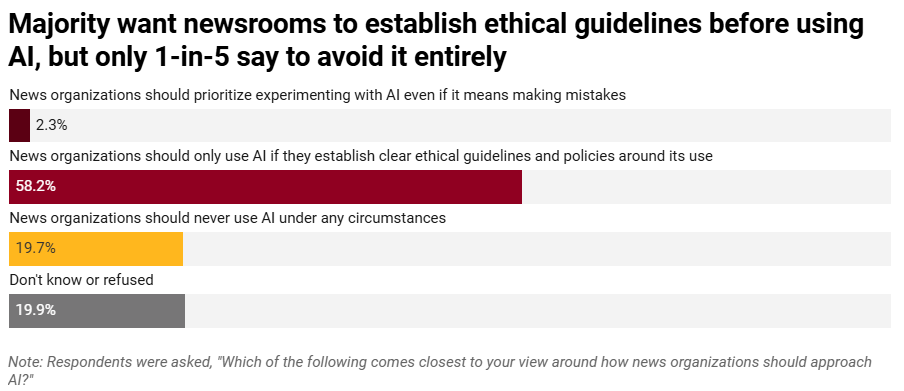A recent Pew Research survey of AI experts and the general public highlighted just how far apart those two factions were in terms of their optimism and concerns, respectively, regarding AI’s impact in the coming years.
One aspect that both were closer in agreement about was the job-reducing impact AI might have on careers such as software engineers, factory workers, and even journalists.
Further research recently released by Poynter and the University of Minnesota is helping to illuminate why the public may not be ready for AI in the newsroom, as nearly half of those surveyed said they don’t want news from a genAI chatbot, plain and simple.
“The data suggests if you build it, do not expect overwhelming demand for it,” says Benjamin Toff, director of the Minnesota Journalism Center at the University of Minnesota.
But while 49.1% said they had no interest in chatbots for this role, 39.3% would be open to using that tool if “editors verified information in the answers” to ensure accuracy. As Poynter’s Alex Mahadevan points out, asking about chatbots can be “tricky” if only because people’s experience with chatbots are in a customer-service capacity, not one based around news.
The research found that around two-thirds of those surveyed believe the media is already “using AI for editorial applications at least sometimes,” for such tasks as making infographics and images when necessary, turning text into audio or video, and even writing article text — which 27.3% believe the media does often and 4.5% believe does “always.”
How Audiences Think Journalists Use AI
“There’s a clear disconnect between what journalists are actually doing with generative AI and what audiences think they’re using it for,” writes Mahadevan, pointing to the importance of transparency and disclosure about AI use even with human editorial oversight. 55.6% said that disclosure is “very important” with photo editing, and 52.3% said it was very important for writing news-story text.
More than half (58.2%) believe AI should only be used if “clear ethical guidelines and policies around its use” are established by news organizations.

(Source: Poynter and the University of Minnesota)
And it’s from that necessary foundation of planning and transparency where I stand, knowing that AI’s best value in publishing is when organizations find and take advantage of the tools that make sense for them, their work, and their audiences. As Mahadevan writes, the specific uses of automated summaries, explainers, and chatbots can bring “casual readers closer to the story,” but even the untold AI tools still in their infancy wield that promise when held by the capable hands in our industry.
“These tools can make packaging that information, all of that context, all of that background information that a lot of people just don’t have, and make that news more accessible to people,” says Toff. “I think there’s a real opportunity there to reach more and more of the public who right now feel pretty disconnected from news and its value.”
SEE FOR YOURSELF
The Magazine Manager is a web-based CRM solution designed to help digital and print publishers manage sales, production, and marketing in a centralized platform.





